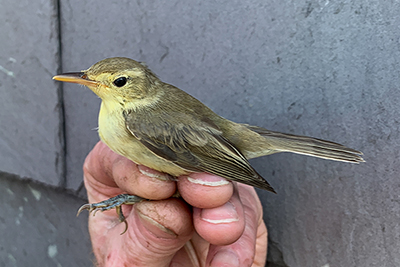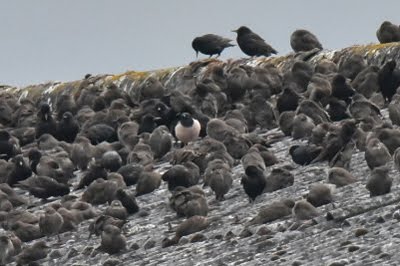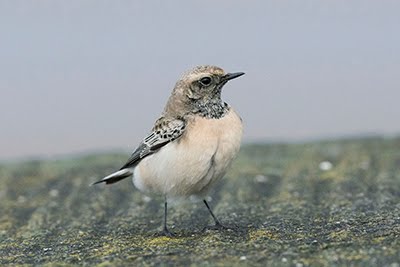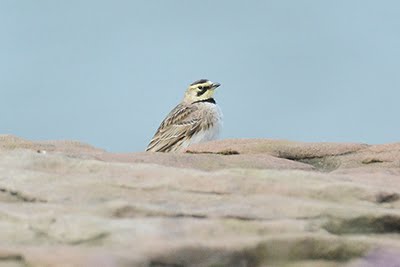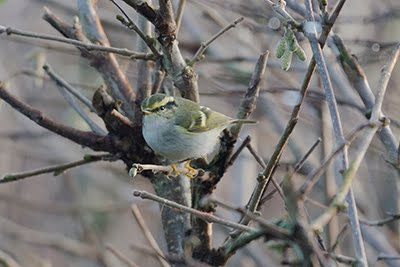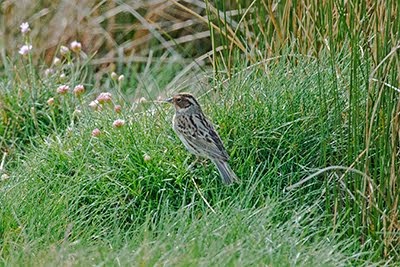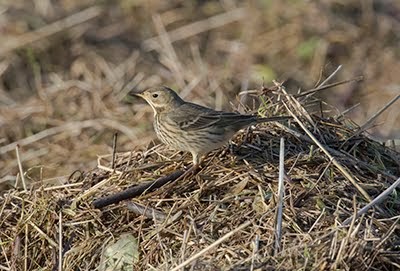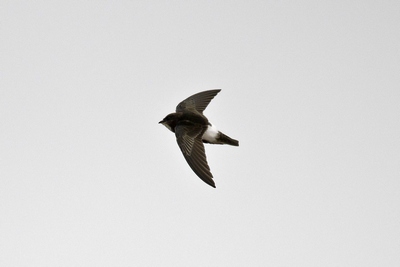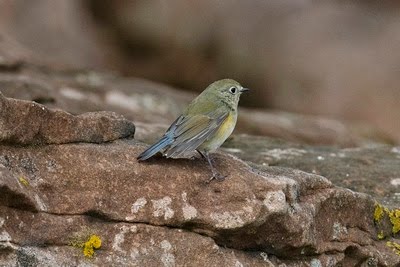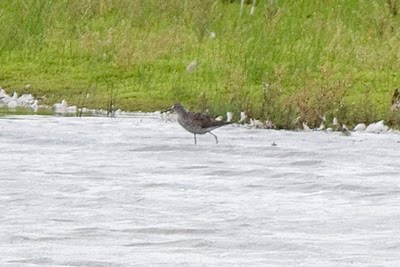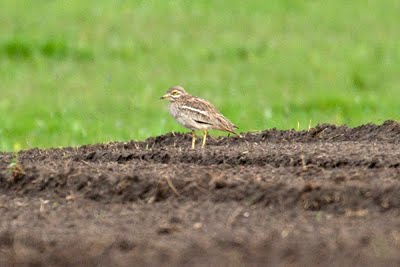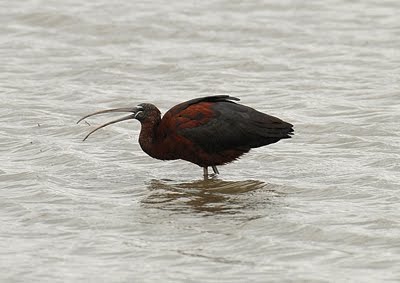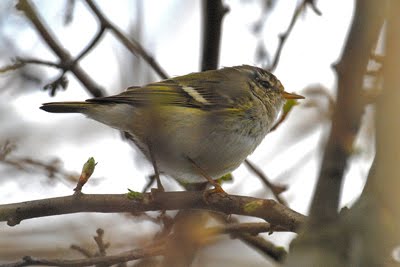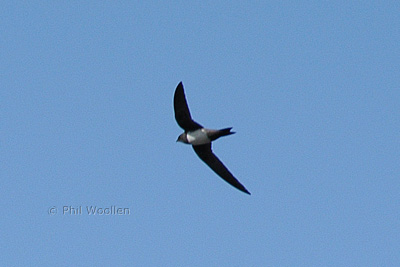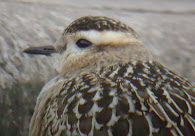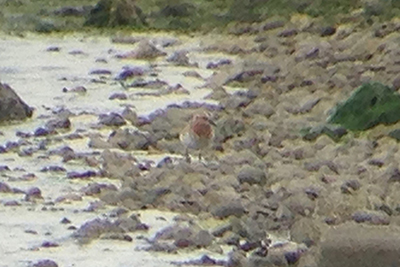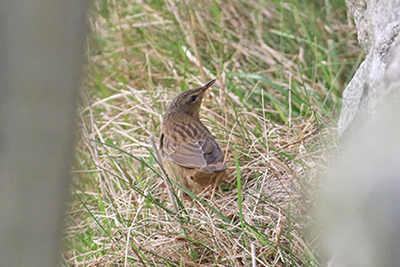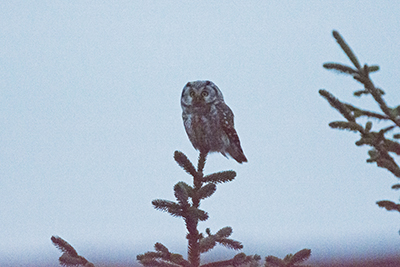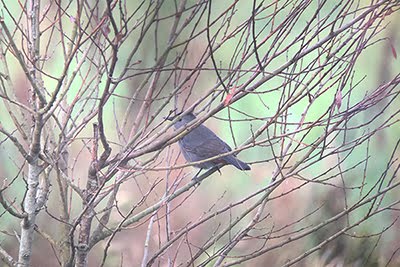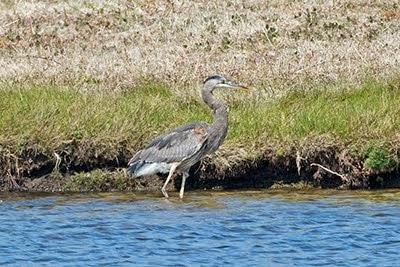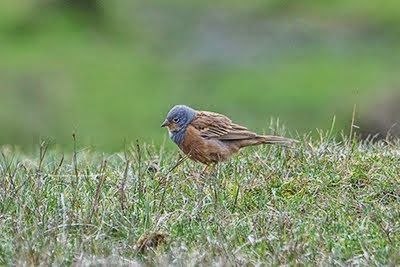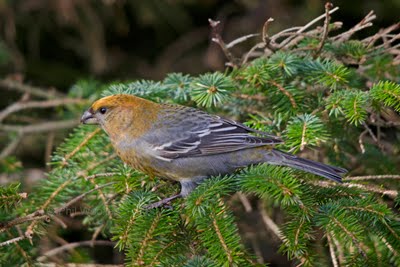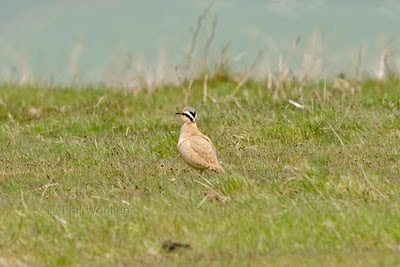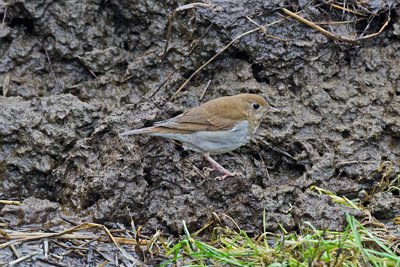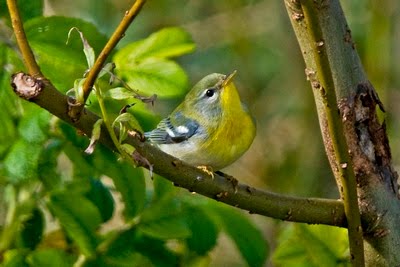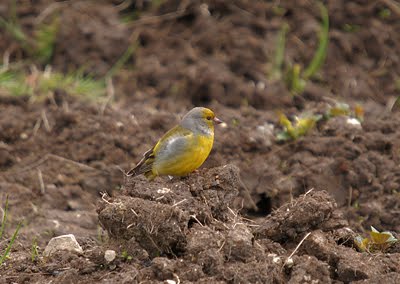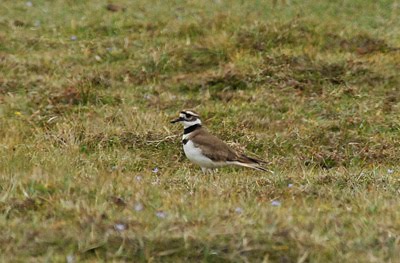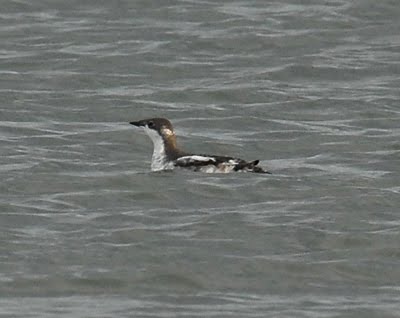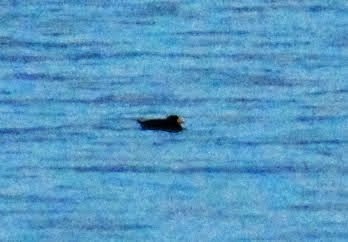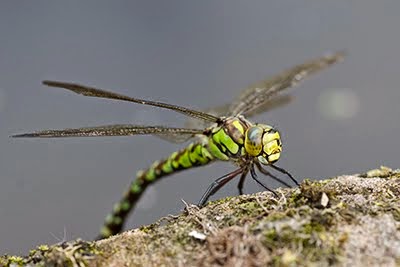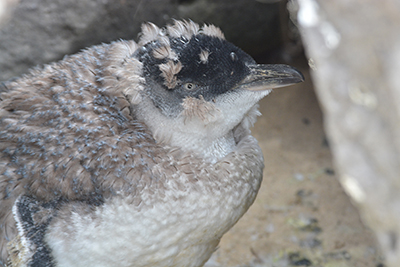Our annual trip to Shetland is coming up over the next week - with Yellow-browed Warblers pouring into the Northern Isles along wit ha White's Thrush., Pallas's Grasshopper Warbler and no less than two Lanceolated Warblers already and the wind staying in the S E until the weekend expectations are high............
A lot nearer home things have been relatively quiet with few migrants on Hilbre and the occasional Chiffchaff or Willow Warbler passing through the garden. Highlight for me was spending another intensive day at Foxglove Covert LNR ringing this weekend. A nearly start saw us putting nets up on nearby moorland, in the dark and surrounded by mist, to try and catch some passage Meadow Pipits. There were hundreds of birds moving and we ended up catching about 105. The majority, as expected, were juveniles.
Back at the main ringing base they were kept equally busy with a surprising number of Coal Tits. We joined them around midday once the Meadow Pipit passage had tailed off. There had obviously been a movement overnight. The bonus for me was getting to process a retrap Marsh Tit and a Tree creeper. A fantastic though tiring day at this reserve in the middle of Catterick Army base.
I also paid a visit to Inner Marsh Farm RSPB where dropping water levels had revealed a lot of mud and attracted in a good variety of waders and this juvenile Heron
Spotted Redshanks, Black-tailed Godwits, Lapwings and Ruff roosted amongst the Teal and Mallard whilst cryptically camouflaged Snipe roosted in the reedy margins.
30 Sept 2013
23 Sept 2013
Peak wader time and a Yankee Sandpiper
Al Conlin texted me last week - its coming up for peak American Wader time on the Wirral coast as the commoner waders start flooding in to the Dee Estuary and the autumn gales start blowing strays and waifs across the Atlantic - he texted me to let me know and expectations were high.
With a slight SE wind blowing Saturday morning hopes were high for a bit of passerine passage on Hilbre before the tide. A few Robins and a couple of Chiffchaff's later it was time to beat a hasty retreat from the island as the incoming tide rapidly flooded the track. No sooner had I got home and washed the sand off the Landrover then Alastair rang to say a probable Semipalmated Sandpiper had been found by Jane off Hoylake prom. A quick call to Allan and we were on our way albeit very conscious of the fact the ebbing tide would mean the waders getting further away. Sure enough 5 minutes from site we received a call saying the bird had flown further out. Our luck was in though and just as we arrived Allan relocated the bird............a long way off!
It was very active amongst the roosting flock of Dunlin, Curlew Sandpipers and Ringed Plovers. It was very easy to pick out as part from its diminutive size it was the only bird moving. Cranked up to 55 x on the 'scope it was just possible to pick up the palmation's as the bird walked away from you. The cold grey tones with no rufous in the scapulars suggested an adult moulting out of summer plumage. Photography was out of the question so I settled for a record shot through the phone.
With a slight SE wind blowing Saturday morning hopes were high for a bit of passerine passage on Hilbre before the tide. A few Robins and a couple of Chiffchaff's later it was time to beat a hasty retreat from the island as the incoming tide rapidly flooded the track. No sooner had I got home and washed the sand off the Landrover then Alastair rang to say a probable Semipalmated Sandpiper had been found by Jane off Hoylake prom. A quick call to Allan and we were on our way albeit very conscious of the fact the ebbing tide would mean the waders getting further away. Sure enough 5 minutes from site we received a call saying the bird had flown further out. Our luck was in though and just as we arrived Allan relocated the bird............a long way off!
It was very active amongst the roosting flock of Dunlin, Curlew Sandpipers and Ringed Plovers. It was very easy to pick out as part from its diminutive size it was the only bird moving. Cranked up to 55 x on the 'scope it was just possible to pick up the palmation's as the bird walked away from you. The cold grey tones with no rufous in the scapulars suggested an adult moulting out of summer plumage. Photography was out of the question so I settled for a record shot through the phone.
Other commitments meant I couldn't go and help with the search Sunday. A very frustrating day for the observers on site as it appeared to show distantly and then promptly disappeared as they moved to view from a better position. Hopefully it'll get relocated.
17 Sept 2013
When the N W wind blows it's Leach's time!
With good seawatching conditions forecast off the N Wirral coast plans were made to spend some time in the seawatching hide on Hilbre. I've got a numb arse from sitting from sitting on a hard wooden seat for 14 hours over the last few days Its been worth it though as we've had the first prolonged strong N W gales of the autumn blowing in to Liverpool Bay. With these gales come the Leach's Petrels!
Fantastic little birds and a real Wirral speciality. In addition to the Leach's I had a single Storm Petrel.
As well as these little gems we've had a good number of L T Skua's with one Sunday, two yesterday and a stunning adult today. Photo's will appear later on the Hilbre blog. I managed a record shot but with the hide packed like a tin of sardines I couldn't move the camera quickly enough to get it as it flew directly in front of us. At least it was cosy.
This was my first adult off Hilbre!
Arctic Skua's have been scarce with only a couple of birds being logged but we did manage a marauding Bonxie that was paying close attention to a couple of exhausted Manx Shearwaters.
Kittiwakes were few and far between but it was nice to log more juveniles than adults.
As usual in these conditions you get plenty of Manx Shearwaters:
Another highlight was juvenile Black Tern that was seen three times on Monday as it battled against the wind. The first Brent geese of the autumn also made an appearance with the first bird being seen at the weekend and three more today.
Common Scoter have also been seen in good numbers - generally on the ebbing tide. Counts of 100+ have been recorded but they are usually a long way out.
This jack up rig is currently moored adjacent to the wind farm off the north end of Hilbre and illustrates Health & Safety gone mad. Note the big white arrows along the side, pointing downwards, showing which way up it should be
Fantastic little birds and a real Wirral speciality. In addition to the Leach's I had a single Storm Petrel.
As well as these little gems we've had a good number of L T Skua's with one Sunday, two yesterday and a stunning adult today. Photo's will appear later on the Hilbre blog. I managed a record shot but with the hide packed like a tin of sardines I couldn't move the camera quickly enough to get it as it flew directly in front of us. At least it was cosy.
This was my first adult off Hilbre!
Arctic Skua's have been scarce with only a couple of birds being logged but we did manage a marauding Bonxie that was paying close attention to a couple of exhausted Manx Shearwaters.
Kittiwakes were few and far between but it was nice to log more juveniles than adults.
Another highlight was juvenile Black Tern that was seen three times on Monday as it battled against the wind. The first Brent geese of the autumn also made an appearance with the first bird being seen at the weekend and three more today.
Common Scoter have also been seen in good numbers - generally on the ebbing tide. Counts of 100+ have been recorded but they are usually a long way out.
This jack up rig is currently moored adjacent to the wind farm off the north end of Hilbre and illustrates Health & Safety gone mad. Note the big white arrows along the side, pointing downwards, showing which way up it should be
12 Sept 2013
The last of the Swallows......
There are still Swallows knocking around but the majority seem to have deserted the breeding areas. This adult and juvenile have nested nearby and are still hanging around the vicinity. I was in Sweden this week and there are still loads of Swallows and White Wagtails still over there but the Fieldfares are massing in flocks around Stockholm. It'll soon be time to welcome the winter visitors................
Plenty of action in the garden and Greenfinch numbers are seemingly up on the last couple of years so it looks as if they've had a good breeding season. My ringing figures show that the number of Greenfinches caught as a percentage of the total is already 7.6% this year whereas last year it was 6.9% and the year before that 1.6%. Its to soon to hope the numbers are bouncing back after the outbreak of Trichomonas a couple of years ago.
Young Chaffinches and Goldfinches seem to be around in good numbers as well.
I had a great day canon netting waders with the SCAN ringing group on Lavan Sands, N. Wales last weekend. Not many birds caught but they did include a Finnish control. It just goes to show how internationally important our estuaries are for wintering waders.
Plenty of action in the garden and Greenfinch numbers are seemingly up on the last couple of years so it looks as if they've had a good breeding season. My ringing figures show that the number of Greenfinches caught as a percentage of the total is already 7.6% this year whereas last year it was 6.9% and the year before that 1.6%. Its to soon to hope the numbers are bouncing back after the outbreak of Trichomonas a couple of years ago.
Young Chaffinches and Goldfinches seem to be around in good numbers as well.
I had a great day canon netting waders with the SCAN ringing group on Lavan Sands, N. Wales last weekend. Not many birds caught but they did include a Finnish control. It just goes to show how internationally important our estuaries are for wintering waders.
4 Sept 2013
Elephant Hawkmoth Caterpillar
I came across this beauty crawling across the patio last night!
When I picked it up it withdrew its head and thrashed its body from side to side so the false 'eyes' were on display - enough to deter your average avian predator.
1 Sept 2013
Stilt Sandpiper in Cheshire
I'm halfway up a ladder with an electric hedge cutter in my hands trimming the in-laws conifer hedge when the phone rings with news from Mark that a possible Stilt Sandpiper has been found on Neuman's Flash. Don't worry, were his words, it'll probably be a Curlew Sandpiper.
Fifteen minutes later I've got the Landrover loaded with hedge clippings ready for the tip and the phone goes again. This time his voice is slightly more panicky - 'it is one mate, I'm on the way'
Shit. No bins, no scope, no camera, no fuel & my wallets at home. Everything has been removed from the back of the Landrover to make room for the afore mentioned hedge clippings!!!!
Off loading the greenery in record time I'm soon loading up with the birding essentials stashed in the garage and on my way. A few quick calls to other local birders to let them know & I'm soon there. Almost. Taking a wrong turn I ended up having to drive through Northwich.
Arriving I meet a happy Allan Conlin,who'd missed the last County record in 1984, walking back to his car. Next up is a beaming Pod & Gregsy. Quickening the pace I get to the view point and get my 'scope on this rare American wader. Excellent.
A bit distant but I managed one record shot with the phone against the 'scope.
Subscribe to:
Posts
(
Atom
)


































